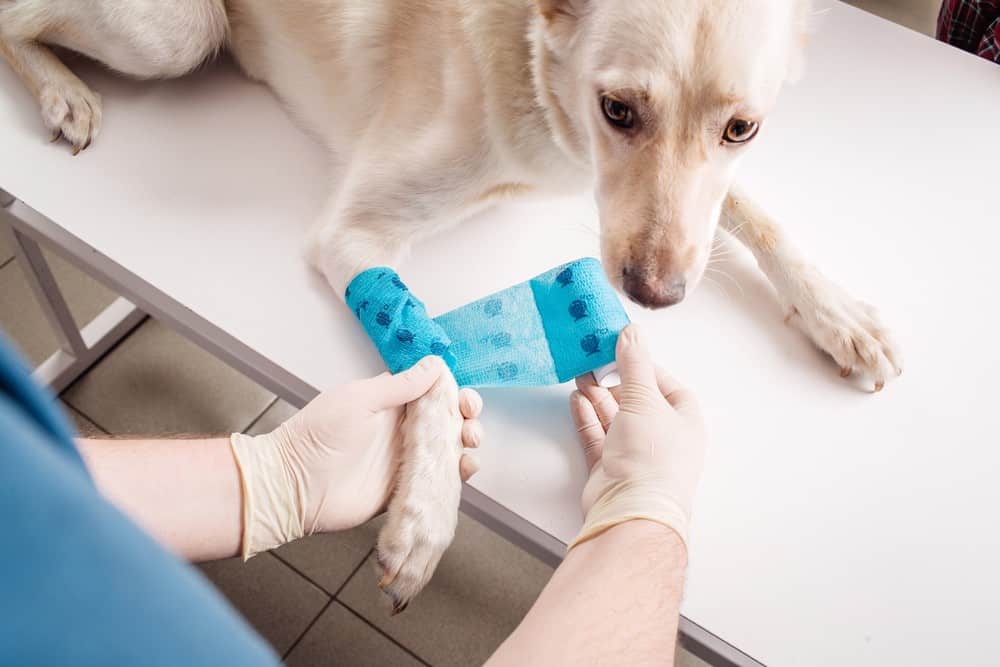Few things are worse than seeing your four-footed friend in pain.
Pain not only hurts (source: Captain Obvious M.D.), it causes significant stress too. And as most doctors and vets will tell you, stress makes pain worse, thereby sparking a vicious cycle that may greatly reduce your dog’s quality of life.
So, most owners are keen to relieve their dog’s pain whenever possible. We’ll talk about the various ways to do so below, but first, we’ll talk about some of the best ways to determine if your dog is hurting.
Key Takeaways: What Can I Give My Dog for Pain?
- It is important to know how to recognize when your dog is in pain, so you can provide your pet with some relief. A few of the most common signs that your doggo is in pain include agitation, restlessness, anxiety, rapid breathing, and a reluctance to do daily activities.
- Minor pain may not always require treatment, but moderate to severe pain absolutely requires attention. Not only is this simply the humane thing to do, but pain can cause severe stress and reduce your dog’s quality of life.
- There are a variety of pain killers that may help pets, but you should NEVER give your dog pain medications without first getting your vet’s approval. Many pain-reducing medications — even things like ibuprofen — can be deadly for four-footers.
- In addition to medications, there are other strategies you can use to reduce your pet’s pain. This includes things like physical therapy, massage, and dietary changes.
Dog Pain Symptoms: How to Tell If Your Dog Is in Pain
Your dog can’t tell you when she’s in pain, so you’ll have to do a bit of detective work on her behalf.
Fortunately, there are a few relatively reliable signs that can indicate your pup is suffering. These include:
- Agitation
- Generalized hyperactivity
- Restlessness
- Inability to settle or get comfortable
- Anxiety
- Trembling or shaking
- Vocalizations
- Guarding behaviors (moving in a way that helps protect the wounded area)
- Localized tenderness
- Panting or rapid breathing
- Increased heart rate
- Reluctance to engage in common activities (walking around, climbing stairs, etc.)
- Depression (sleeping more often than normal, reduced enthusiasm, etc.)
- Limping or altered gait
- Strange body postures
Some of these signs are admittedly subtle or vague, but fortunately, several often occur simultaneously, which will make it easier for you to deduce that your dog is in pain and identify the afflicted area.
For example, you may notice your dog breathing very quickly and acting a bit anxious. Then, when you check her out, she won’t let you touch her paw and limps away. You needn’t consult Dr. Gregory House to figure out that your pooch’s paw or leg is hurting.

Conversely, there are also occasions during which it can be difficult to identify the painful area or be sure that your dog is in pain. For instance, a depressed or lethargic dog may just be having a bad day, or she may be suffering from any number of painful ailments.
You’ll want to contact your vet anytime you feel like your dog is experiencing moderate or long-term pain, especially if you aren’t sure which area of the body is causing the trouble.
Is It Always Necessary to Treat Pain?
Obviously, pain exists along a spectrum, and minor pain isn’t always a big deal. You probably don’t need a morphine drip to get through a sprained ankle, nor would your dog need pain relief for run-of-the-mill, day-to-day injuries.
It’s unlikely your dog will suffer very much if, for example, she steps on a thorn. It’ll sting, but it probably won’t cause serious pain, and the pain will probably disappear entirely once you do the whole mouse-and-the-lion bit.
These types of minor injuries probably don’t require any pain medication or therapy at all – especially if your dog isn’t demonstrating any signs that indicate she’s in pain.
But other types of pain can have quite an impact on your dog’s well-being. This not only includes things like traumatic injuries and cancer, but the pain associated with chronic conditions, such as arthritis or hip dysplasia too. In these cases, pain management is certainly appropriate and humane.
Ultimately, you’ll want to consult with your vet about your dog’s pain and the best treatment strategies to implement.

Common Medications Used to Treat Pain in Dogs
There are a variety of different medications used to treat pain, and different ones are better suited for treating some types of pain more than others. We’ll discuss some of the most effective and commonly administered medications below.
Never provide any of these medications to your dog without first consulting your veterinarian.
Stop. Go back. Read that again.
Some of these medications can make your dog very ill, and you should never administer them without first speaking with your vet.
In fact, many of these medications are not specifically approved for use in dogs. “Off-label” use is perfectly fine with your vet’s guidance, but the improper use of human medications can cause serious health problems or death.
We’ll start by discussing the medications vets most commonly recommend, and then we’ll move on to a few over-the-counter pain medications, which vets may recommend from time to time.
Note: Most medication dosages use kilograms, rather than pounds. Just remember that 1 kilogram = 2.2 pounds, if you need to convert the units. Additionally, the information provided is only intended for informational purposes — always rely on your veterinarian’s advice regarding proper dosage.
Carprofen
Carprofen is a NSAID that is used to treat mild to moderate pain associated with musculoskeletal issues, osteoarthritis, and surgical recovery. While carprofen was briefly used in human medicine, it is now solely used in veterinary medicine.
Carprofen is typically prescribed at a rate of 4.4 milligrams per kilogram of body weight. While most dogs tolerate carprofen well, side effects occur at about the same rate (1 report per 500 cases) as they do with many other NSAIDs.
Some vets prefer to administer an injectable form of the medicine, although this will only provide about 24 hours of relief.
Ketoprofen
Ketoprofen is a medication used to treat acute pain and is rarely prescribed for more than five days at a time. Vets usually administer ketoprofen as dosages of 1 milligram per kilogram of body weight, either via an oral tablet or an injection.
Ketoprofen often causes the same types of side effects that other NSAIDs do, including gastrointestinal bleeding and ulcers. It can also reduce the blood’s ability to clot.
Etodolac
Etodolac is another NSAID that is FDA-approved for use in dogs. It is typically administered at a rate of 10 to 15 milligrams per kilogram of body weight, and relatively few side effects are observed at this dosage range.
Etodolac is often specifically used to treat the pain and immobility caused by hip dysplasia.
Meloxicam
Another NSAID approved for use in dogs, meloxicam (also goes by the brand name Metacam) comes in two different liquid forms, including an oral solution and an injectable form. Meloxicam doesn’t usually cause gastrointestinal problems as often as many other NSAIDs.
Vets typically administer a relatively high “loading dose” of 0.2 milligrams per kilogram at the onset of treatment, but subsequent doses are reduced to 0.1 milligrams per kilogram. Once the pain is brought under control, the dosage is usually reduced until the lowest effective dose possible is achieved.
Phenylbutazone
Phenylbutazone was one of the first NSAIDs approved for canine use by the FDA, but it is also an important drug used to treat pain in horses. It is usually administered in tablet form to dogs, but it is also available as a gel or paste.
While this drug is typically considered pretty safe, most vets try to prescribe it at the smallest dosage possible to limit side effects, which can include gastrointestinal bleeding, ulcers, and bone marrow suppression. Phenylbutazone is usually administered at a rate of 3 to 7 milligrams per kilogram of body weight.
Firocoxib
Firocoxib is another pain killer vets sometimes prescribe for pain in dogs — especially those suffering from osteoarthritis.
Sold under the brand name Previcox, firocoxib is a selective Cox-2 inhibitor, which means it prevents one of the primary enzymes responsible for causing pain. This means that it doesn’t often trigger the gastrointestinal issues and side effects many other pain medications do.
Firocoxib is only available with a prescription from your vet, and it is typically administered at a rate of 2.27 milligrams per pound of body weight.

The following medications are usually intended for human use, but vets occasionally prescribe them in special circumstances.
Aspirin
Aspirin (acetylsalicylic acid) is a NSAID (non-steroidal anti-inflammatory drug) medication that is typically used to treat pain associated with musculoskeletal issues or osteoarthritis. However, aspirin can cause gastric ulcers and reduces the blood’s ability to clot, so it is rarely recommended for long-term use.
Dosage regimens vary based on the health and history of the afflicted animal, but most vets consider 10 to 40 milligrams per kilogram to be the appropriate aspirin dosage for dogs.
Note that aspirin is deadly to cats, so never administer it to your feline friends.
Acetaminophen
Acetaminophen (better known as Tylenol) is another common over-the-counter pain medicine that vets occasionally recommend for dogs. Tylenol works in relatively similar fashion to aspirin, but it does not cause gastric ulcers or blood-clotting problems aspirin may trigger.
Vets usually advise dosages ranging from 10 to 15 milligrams of acetaminophen per kilogram of your dog’s body weight.
Opioids
Opioid painkillers – including morphine, fentanyl, buprenorphine, and hydromorphone, among others – are often used to treat severe pain in dogs. Opioids are only available via prescription, and they can cause serious (potentially fatal) side effects, so they should only be used when necessary and under close veterinary supervision.
Opioids are typically reserved for treating things like cancer and severe osteoarthritis. Opioids are also some of the best pain meds for dogs after surgery.
Different opioids are used to treat different types of pain, and they’re administered in dosages ranging from 0.005 to 10 milligrams per kilogram of body weight, depending on the drug selected and your dog’s health.
Tramadol
Tramadol is occasionally prescribed for pain in dogs, but it’s rapidly falling out of favor among veterinarians.
Originally thought to work like an opioid painkiller, recent research suggests that it functions more like a tricyclic antidepressant. In humans, tramadol causes the production of one key metabolite that’s effective in treating pain — known as the M1 metabolite. But in dogs, the drug triggers the production of more than 30 different metabolites, with the amount of M1 produced varying among individual doggos.
This occasionally results in dogs who experience negative cognitive effects from the medication, without enjoying much pain relief.
Corticosteroids
Corticosteroids (both naturally-occurring and synthetic forms) help halt the body’s inflammatory response, which can help alleviate or reduce some types of pain – particularly pain associated with allergies, arthritis or skin disorders. Many corticosteroids are manufactured in injectable form, but oral formulations also exist and are easier for owners to administer.
Corticosteroids can cause a number of health problems when used over a long period of time, so vets prefer to use them for as short a period of time as is possible.
Gabapentin
Gabapentin is an old medication, which has been used in human medicine to treat everything from seizures to pain to restless leg syndrome. However, many veterinarians use it to treat pain and other conditions in dogs too.
Gabapentin is rarely taken on its own; instead, it is usually administered along with an opioid or NSAID, as it appears to enhance the efficacy of these drugs. Gabapentin has shown very promising results in the treatment of long-term, mild-to-moderate pain.
CBD
CBD is an abbreviation for cannabidiol — one of the active ingredients (termed cannabinoids) in marijuana. CBD has become quite a popular medication among people suffering from a variety of ailments, including chronic pain and arthritis. And not surprisingly, some owners have even begun using it to treat similar conditions in their dogs.
There isn’t yet a great deal of research on the use of CBD in dogs, but it appears largely safe and a few studies have generated positive initial findings.
It may even turn out that CBD is a fantastic natural anti-inflammatory for dogs — we just don’t know yet.
Be sure to check out our guide to CBD oils for dogs to learn more about the subject, including the legal issues involved.
Note that CBD doesn’t cause the mind-altering effects for which cannabis is famous (THC is the primary psychoactive cannabinoid in the plant), so you don’t have to worry about it making your dog stoned. THC can actually make dogs feel pretty rotten, so don’t give your dog regular weed.
Amantadine
Amantadine is another painkiller that is occasionally prescribed to pets (though it is also FDA-approved for treating influenza A and Parkinson’s disease in humans).
It is generally used in cases in which opioids are not effectively addressing a pet’s pain, but it is also used to treat long-term, chronic pain in a homecare setting. Accordingly, it is usually prescribed for at least three weeks, and some dogs will end up taking it forever.
Interestingly, amantadine is not terribly effective on it’s own — it is usually prescribed in conjunction with pet-safe NSAIDs, opioids, or gabapentin. When used this way, amantadine appears to boost the efficacy of the other drugs, thereby helping to keep Fido comfortable.
Amantadine is usually administered in tablet form, at a dosage of 3 to 5 milligrams per kilogram of bodyweight. It is typically administered once every 24 hours.
Ketamine
Ketamine is another drug that’s occasionally used in the treatment of pain — especially “wind up” or visceral pain (pain that affects the internal organs). It is also used during surgical procedures to prevent patients from unconsciously reacting to pain.
An injectable drug, ketamine is typically administered in dogs at a rate of 0.5 milligrams per kilogram of bodyweight. Accordingly, and because of the drug’s Schedule III status, your vet won’t send you home with it — he or she will administer it in an office setting.

Non-Medicinal and Natural Pain-Relief for Dogs
Medicines aren’t the only way to treat pain – there are several different techniques your vet can use to help your pooch feel better. You can even implement a few of these strategies on your own, without your vet’s help (but you should always keep them in the loop).
Some of the most effective options include:
Surgery
Surgery is the most invasive non-medicinal strategy for treating pain, but it is often the most effective. In many cases, it is the only viable solution. Different types of pain require different surgical solutions, and some are more elaborate than others.
For example, dogs suffering from hip dysplasia occasionally require total hip replacement surgery, which is as invasive as it sounds. Spinal problems, tumors, and urinary tract stones can also require relatively invasive surgeries.
By contrast, dogs suffering from sprained ligaments or minor gastrointestinal problems may be good candidates for laparoscopic procedures. These surgeries are often performed via long, flexible cameras and instruments, thereby alleviating the need to make gigantic incisions.
Physical therapy
Physical therapy varies based on the type of ailment being treated, but it usually consists of a variety of stretches and exercises to resolve mechanical problems with the musculoskeletal system. It won’t be of much use when treating tumors or digestive problems, but it can do wonders to help reduce the pain associated with musculoskeletal injuries.
Hydrotherapy
Hydrotherapy is essentially physical therapy that takes place in a warm pool. The therapist will have your dog enter the water and go through a series of stretches, mobility-increasing movements, and exercises. Because water imparts more resistance and support than air, it can be very effective for treating a variety of muscle-, tendon-, and joint-related pains.
Hydrotherapy also allows your dog to get a bit of exercise without having to endure the impact that traditional exercise often entails. As a bonus, the warm water helps to alleviate musculoskeletal pain too.
Massage
People have been using massage therapy to help reduce pain for centuries, and many practitioners have begun treating dogs too – some even specialize in canine massage. Massage comes in a variety of flavors, from those based on soothing and gentle Swedish-inspired techniques to more aggressive trigger-point and deep-tissue approaches.
Accordingly, massage can be helpful for treating a variety of different problems, such as sore or tight muscles. Massage is often grouped into the “alternative medicine” category, but unlike many other such treatments, there is some empirical data to support its practice (most such evidence concerns humans, but it’s likely applicable to dogs too).
Acupuncture
Acupuncture represents another potential solution to your pet’s pain.
Thought to have been developed in China at least 3,000 years ago, acupuncture involves the insertion of small needles in specific portions of the body. This helps to change the way nerve impulses travel to the spinal cord, thereby helping to alleviate some of the pain. The process also releases endorphins in the brain, which further helps to reduce pain and promote relaxation.
The practice isn’t always effective, and it is better for treating some types of pain (primarily musculoskeletal pain) than others (such as visceral pain). However, it is considered quite safe, rarely causes serious side effects, and many dogs appear to enjoy (or at least, tolerate) acupuncture sessions.
Just note that not all veterinarians provide acupuncture services, so you may have to hunt around a little to access this kind of care for your doggo.

Dog Pain Relief: Home Remedies
While the strategies listed below won’t provide immediate pain relief, they may help to reduce many types of discomfort and improve your dog’s quality of life.
Increase / Decrease Exercise
Some types of pain may improve with increased exercise, while some others may improve with increased rest. You’ll need to discuss the issue with your vet, but in either case, this is a very easy solution. Just be sure to avoid high-impact activities if your dog is suffering from joint problems.
Provide Your Dog with an Orthopedic Mattress
No matter what type of pain they experience, dogs who enjoy a good night’s sleep will likely feel better than those who don’t sleep well, so it is always a good idea to ensure your dog has a high-quality orthopedic mattress. Additionally, the support and comfort these beds provide can reduce pain associated with hip dysplasia, arthritis, and spinal problems.
Give Your Dog a Heated Mat or Bed
Laying on a warm surface helps to improve blood flow and reduce mild to moderate musculoskeletal pain, such as occurs in dogs suffering from hip, leg or spine problems. Just make sure that any heated bed or mat you choose provides a soft surface on which your dog can lay.
Moisten Your Dog’s Kibble or Switch to Wet Food
Whether due to old age, decay, or trauma, many dogs suffer from oral pain. This can make it very hard for them to eat, and many may begin refusing food entirely. However, by moistening your dog’s kibble or switching to a canned food, you can make it easier for your dog to eat and help eliminate the pain associated with dental problems.
Provide Your Dog with Warm Clothing
Cold temperatures can exacerbate some types of pain, so you may want to consider outfitting your dog with a sweater or jacket during the winter. Big dogs typically remain warmer than small dogs, so you may want to put a sweater on your Labrador just while going on walks outside; your Yorkie, on the other hand, may need to wear it 24-7.
Provide Your Dog with Booties
Dogs who’ve suffered foot injuries may enjoy the protection and warmth that booties provide. They’re especially helpful for walks that take place during cold temperatures or inclement weather, but they may also protect your pup’s feet from hot sidewalks during the summer.
Booties may also help dogs suffering from leg or joint problems enjoy better traction on slippery floors.
Increase the Amount of Omega-3 Fatty Acids Your Dog Receives
Omega-3 fatty acids help to reduce inflammation, which may help relieve some of the pain associated with arthritis, hip dysplasia, and similar ailments. Some foods contain ingredients (such as salmon and flaxseed, among others) that are rich in omega-3 fatty acids, but you can also purchase stand-alone omega-3 fatty acid supplements if you’d prefer.
Keep Your Dog in Tip-Top Shape
Maintaining a proper body weight won’t directly alleviate your dog’s pain, but it can help reduce the strain placed on her muscles and joints, which may help her feel a bit better. Discuss your dog’s body condition with your vet and find out an ideal target weight for your pup.
It isn’t always easy to help dogs lose weight – particularly if they are already suffering from health problems that limit their mobility. In such cases, you may need to switch to a low-calorie food.
Take Care of Your Dog’s Emotional Well-Being
Stress, depression, and anxiety can all make pain worse, so do your best to keep your dog’s spirits high while she’s battling any type of painful condition. Among other things, this means you’ll want to ensure she’s adequately stimulated by providing her with plenty of toys and allowing her to exercise as much as is possible with her ailment.
It may also be wise to provide her with a cozy crate, so she has a dark, quiet place to hide when she’s feeling overwhelmed.

Help! My Dog Ate Ibuprofen (or Some Other Pain Medication) – What Do I Do?
As mentioned earlier, ibuprofen, Tylenol and most other over-the-counter pain medications are not safe for dogs unless your veterinarian specifically advises you to administer them. Accordingly, if your dog has helped herself to aspirin or some other pain killer you have laying around, you’ll want to contact your vet or the Pet Poison Hotline at once.
Try to determine how much of the medication your dog has eaten before calling and have the bottle handy so you can answer any questions the vet may have. If possible, have another adult standing by to help you monitor and care for your pet while you talk with the vet.
In some cases, your vet may simply recommend taking a “wait and see” approach, but if your dog has consumed a significant quantity of the meds, a trip to the veterinary hospital will probably be necessary.
Don’t have easy access to a vet? You may want to consider getting help from JustAnswer — a service that provides instant virtual-chat access to a certified vet online.
You can discuss the issue with them, and even share video or photos if need be. The online vet can help you determine what your next steps should be.
While talking with your own vet — who understands the ins and outs of your dog’s history — is probably ideal, JustAnswer is a good backup option.
What Painkillers Are Safe for Dogs: Quick Answers
We’ve covered most of this information above in greater detail, but we wanted to provide a quick answer section for owners in a hurry. This should help you understand what painkillers are safe for dogs, and which ones you’ll need to avoid (spoiler alert: none are appropriate without your vet’s approval).
Can I give my dog aspirin?
Under normal circumstances, no. Veterinarians rarely prescribe aspirin for canines, as it causes a number of side effects and presents several important health risks. Never give your pet aspirin without your vet’s explicit permission.
Can I give my dog ibuprofen?
As with most other over-the-counter painkillers, you should not give your dog ibuprofen, unless your vet recommends that you do so. Ibuprofen, like aspirin and Tylenol, can cause serious health problems in dogs.
Can I give my dog paracetamol (Tylenol)?
Tylenol can be dangerous for dogs, so you shouldn’t give it to your pet unless your veterinarian instructs you to do so. Additionally, note that Tylenol is extremely dangerous for cats, and a single tablet can result in death.
Can I give my dog tramadol?
Tramadol is a synthetic opioid that is sometimes prescribed for humans as well as dogs. However, you should never administer your own medications to your dog – particularly without your vet’s approval. In fact, although tramadol is largely considered safe to use under veterinary supervision, many vets are even moving away from tramadol, as more research shows that it may not provide effective pain relief for canines.
Can I let my dog lay on a heating pad to reduce pain?
Unless your dog has suffered an injury or is dealing with inflammation, a heating pad is usually a safe and effective way to help ease minor pain. This is especially true of older dogs who often suffer from stiff joints during cold weather. Just be sure to set the heating pad on a low setting and supervise your dog so that he doesn’t start chewing on the cord.
Are any dog pain relief home remedies effective?
There are a few dog pain relief home remedies that appear to be effective, although the evidence is mixed (at best) for some others.
Things like providing your dog with an orthopedic bed or increasing the amount of omega-3s (or other joint-supporting supplements, such as chondroitin and glucosamine) may provide some relief, depending on the nature of your pooch’s pain. This certainly isn’t guaranteed, but there’s little downside in trying.
Additionally, changing the amount of exercise your dog gets and ensuring that your dog is happy and stress-free may also help.
It’s always difficult to see your pup in pain, but with veterinary assistance and a bit of effort, you can usually help your pooch feel better.
Tell us about your experiences treating your dog’s pain below – your story may help others find a good way to treat their own dog.









Leave a Comment